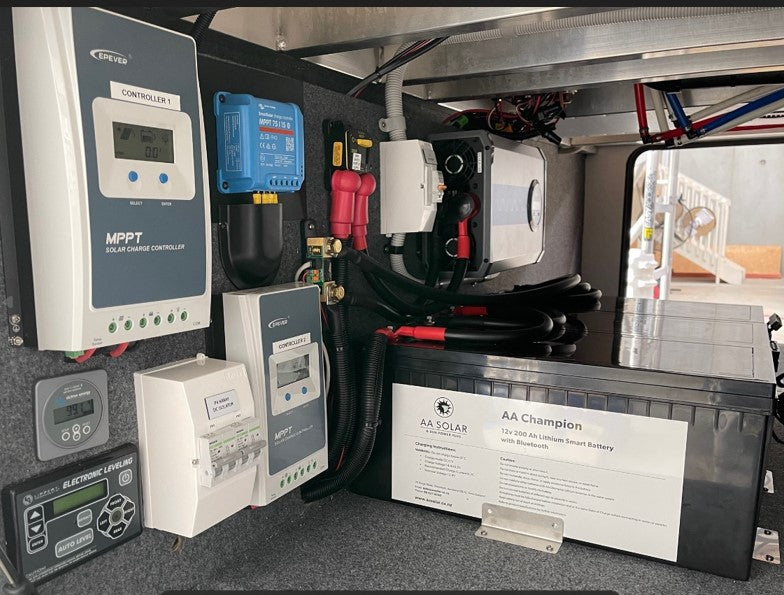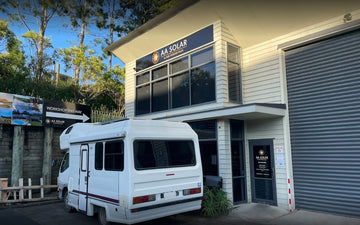With every component in a solar system, many options have varying specifications, features, and even lifespans.
- Battery types and size: The battery needs to be big enough to run your devices and be fully recharged by your solar panels. In an RV or boat solar system, AGM and Lithium deep-cycle batteries are the most popular.
- Solar panel type and size: The primary consideration with panels is their physical size, weight and what you can fit where on your roof to maximise your potential solar generation. We offer 5W to 670W.
- Solar controller and size: The Solar Controllers convert DC power voltages and solar panels into appropriate battery charging voltages. Batteries or different types require different charging regimes.
- Inverters type and size: An inverter can be installed to convert 12V DC or 24V DC to 230V AC to power AC loads. The most important consideration when choosing an inverter is to ensure that your battery bank will support the load.
Let’s Go Deeper:
Battery Type and Size
To get the system sizing right, you want a battery big enough to run your devices (discharge amount) and enough solar power to recharge them back to full.
If you don’t have enough solar power to recharge your battery, it will eventually run down, and you will damage it – no matter how big the battery is.
Every battery type has a different capacity and lifespan. The Lifespan is measured in Cycles. In an RV or boat solar system, AGM and Lithium deep-cycle batteries are the most popular.
3 Golden rules when it comes to mixing batteries:
- You cannot mix and match batteries of different types as the controllers only support one kind of battery, and you cannot mix and match charge voltages and charging methods.
- You should never add new batteries to a bank of old batteries because the old ones will bring down the new ones. You cannot charge above the level that the old, degraded batteries will accept, shortening the life of your new batteries. They will never get fully charged, and they won’t last.
- You cannot add more than 4 x 12V batteries in a string on any controller as they won’t support any more. 8 x 6V connected in series that appear to the controller as three 12V strings are the maximum for 6V cells.
AGM Batteries
An AGM battery is a fully sealed battery that can be mounted in any orientation and will reliably give you 5-10 years of exemplary service if you treat them well. When we say “treat them well”, – There’s a trade-off between cycles vs discharge levels. If you discharge an AGM battery by 20% of its total capacity, it should last 5-10 years. It could last two years or less if you discharge it to 50% of its maximum capacity.
To size an AGM battery bank where we have 50AH per 24 hours from our battery and only discharge your AGM battery by 20% DOD (Depth of Discharge). To get the maximum lifespan, you would need 250AH (50AH x 5) of the total battery capacity, a MINIMUM of 1 x 260AH battery, or 2 x 130AH batteries in parallel.
We say MINIMUM because the sizing is based upon an average load and does not account for peak loads or times when you cannot get full regeneration from your solar panels due to lousy weather or shading.
As a rule of thumb, calculate your MINIMUM as above and then DOUBLE IT. We recommend 2 x 260AH batteries to provide enough headroom for peak loads, lousy weather, shading, and temperature.
A battery can also lose half of its capacity when extremely cold.
“I thought a 100AH battery would do the trick” – is often what we hear 😊
Lithium Batteries

Lithium batteries are gaining popularity as they have become more economical. The main advantage is their depth of discharge and their long lifespan. They are also smaller and lighter.
You can safely discharge a Lithium battery by 80% of its capacity or 80% DOD. Depending on the Manufacturer, they guarantee 3,000-6,000 cycles, which means a lifespan of 10 or more years.
Being smaller and lighter, a single 100AH battery would give you 80AH of usable power vs 2 x 200AH AGM batteries, which would also provide 80AH but weigh three times more and last half as long.
Often – we talk about the value vs price. Lithium does provide excellent economics over the long term, e.g. ten years or more.
Lithium is more economical if you see yourself in the same vehicle for ten years or more; otherwise, you will run through two sets of AGM over the same period.
Modern lithium batteries are a plug-and-play replacement for most systems as they have built-in BMS (Battery Management Systems) – some even have a smartphone app. These days – suitable solar controllers either support lithium or can be user-programmed to the correct bulk charge they require with little effort when swapping to Lithium.
Mounting Batteries
AGM & Lithium batteries can be mounted in any orientation, e.g. Standing up, on their side or even upside down. These batteries are heavy items and dangerous goods that must be very securely mounted.
We typically use aluminium L-channel cut and screwed to the floor to contain these batteries, which can also be strapped down for extra protection.
Battery Monitors

A battery monitor is a small, computerised device that monitors not just the voltage of your battery bank(s) but also measures the amount of current coming in (solar charge) and going out (your electrical load). These monitors are programmed with the amount of battery capacity connected. Once calibrated, they will give you an accurate real-time estimate of your remaining capacity as a percentage or bar graph. For example, if your batteries are discharged at 10%, the monitor will show 90% capacity.
Most monitors will measure the voltages of your start battery and house battery but will only compute the capacity of the house bank.
Another feature of a battery monitor is its ability to disconnect the DC loads when your battery bank reaches a pre-programmed discharged amount.
For example, you can set the monitor to disconnect the load at 30% depth of discharge. An additional solenoid relay module (sold separately) will physically disconnect the battery to protect it from further discharge. We offer 5-year warranties on our AGM battery range when used with a battery monitor. Without a battery monitor, we can only offer a standard 2-year warranty.








